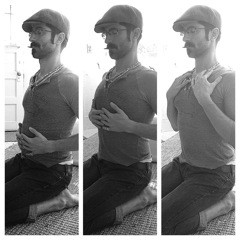Mastering the Full Yogic Breath
by Daniel Scott
It is easy to take breathing for granted, because we don’t have to think about it. Only when we do are we reminded of its importance, and most times, the reminder is forced. Congestion, shortness of breath, and choking are all poignant indicators of what happens when the fuel line to the engine is cut. Most people don’t like being reminded of their mortality, let alone feeling they can’t climb a flight of stairs without keeling over.
Breath is life, and life has the potential to be rewarding, relaxing and easy.
The same goes for meditation. Instead of considering it a laborious process of forcefully clearing the mind, try focusing awareness through non-judgemental observation. For many, the simple act of following the inhale and exhale works better than any practice of visualization.
Introducing the Full Yogic Breath
When breathing with deep mindfulness, a comfortable seat is paramount to success. You’re more than welcome to rock a full lotus if that’s sustainable, but sticking feathers up one’s asana does not a mayur make (yoga joke). Be honest with those hips and knees. The most important thing to take into consideration is maintaining a tall, erect spine. Avoid hunching as much as possible.
If you’ve got tight hips, sitting “normally” with crossed legs on the floor is going to make your legs tired and your back curve. Help yourself out by sitting on a yoga block or some reasonable proximation: rolled up beach towel, throw pillow, two phone books, a six-pack with a flip-flop on top. Whatever the choice, make sure you’re comfortable. We’ll be here for a while.
Gently cross your legs while perched atop this yoga block. With the pelvis raised above the knees, your hip flexors can relax and aid in finding that tall spine with greater ease. This pro tip even applies to seasoned yogis. When I’m getting ready to sit mindfully for extended periods of time, I set myself up with a success cushion.
Alternatively, try sitting in virasana pose with the knees together, the feet just outside the hips, and your butt sitting atop a block placed between the ankles. Many appreciate this posture because it’s easy to visualize and create a tall spine with little pressure placed on the hips. Your feet and shins may get a bit tired, so be sure to do this on a blanket or yoga mat. Let’s do this!
Full Yogic Breath time

–
2. Place your hands on your stomach, slightly interlacing the fingers so that the fingertips come to the second knuckle of the opposite hand. Your navel should feel cradled.
–
3. Begin to breathe deeply into the navel, into the belly (see photo)
–
4. Practice breathing with a controlled, slow breath so that you feel the fingers slide apart on the inhale and back together on the exhale. As much as you try to expand on the intake, see how much you can expel on the out breath. You may find that you can have those fingertips slide together farther than they started. Whether they do or do not, the most important thing here is to work on controlling the breath. Smooth in, smooth out. Notice where you tend to rush or lose control. Work on evening all that out.
–
5. Breathe like this 15-20 times as deeply as you can without discomfort or force.
–
6. Slide the hands up to your ribcage. A good estimation is to have the pinky fingers hang over the edge of your ribs with thumbs right below the pectorals.
–
7. Continue breathing, except now inhale into the belly, in to the ribs. Fill the belly first before expanding the hands on the ribs. Visualize the breath filling in your body from the bottom up. First the belly, then the ribs. Feel the ribs expand in all directions– not just forward, but sideways and into the back body.
–
8. As you exhale, retrace the steps from the inhale. Exhale starting from the ribs, finshing off with the belly. The navel drawing in should help fully expel your air. Don’t force your breath in either direction, in or out.
–
9. Repeat this another 15-20 times. Into the belly, into the ribs. Out from the ribs, out from the belly
–
10. Separate the hands and place them on your chest, resting the palms above the heart center with fingertips gently curled over the collar bones.
–
11. Continue breathing. Start into the belly, into the ribs, into the chest. Filling up your torso with breath from the bottom up, all the way to your fingertips. Feel the breath rise along the spine, expanding the insides in all directions. Exhale the way the breath came in. From the chest, through the ribs, out of the belly.
–
12. This is a great time to remind yourself to keep the spine as tall as possible. Just by following the breath from the bottom to the top, from the top to the bottom, you’re already mindful of how the spine is stacked. Keep it up, intrepid yogi.
–
13. Repeat this 15-20 times.
–
After you’ve found your full yogic breath expanding throughout these three areas of the body, allow the breath to normalize. Pay some attention to how it feels as you inhale and exhale, but don’t try for the deepest breath possible. Find your smooth, natural breath, keeping a tall spine and your eyes closed. You’ll know when to stop. Enjoy the ride.
Perhaps you’re new to the practice of the full yogic breath. Maybe you’ve just fallen out of touch. Honing a skilled connection to your respiration is a lifelong adventure, continually challenging the master and constantly rewarding those who remain diligent. Where every great journey begins with just one step, remember that the rest of you life begins with each new breath.
Why not make every one count?
